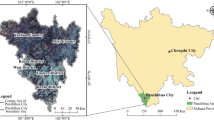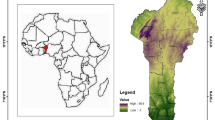Abstract
The Alpine ecological region of Qinghai Tibet Plateau is undergoing significant changes endangering its vulnerability to ecology. Based on Pressure-State-Response (PSR) model, six indexes were are analyzed to evaluate the ecological vulnerability of Nyingchi city in Tibet. The Spatio-temporal ecological vulnerability of Nyingchi city from 2000 to 2015 was quantified based on spatial modeling techniques and observed changes were discussed in the context of space and time. The Ecological Vulnerability Standardized Index (EVSI), which was obtained by accounting different vulnerability levels yielded that the overall vulnerability of Nyingchi is relatively high in the north and gradually decreasing towards the south. The changes observed correlated well with local topography, climate, disaster volume and water conservancy construction. As a result, five levels of ecologically fragility could be defined for Nyingchi city, which shall provide a direction to efforts for ecological restoration and re-construction. From the perspective of ecological restoration and reconstruction planning of restoration and reconstruction can be addressed based on the severity of the vulnerability. Such studies on other vulnerable cities at a closer time periods can establish a continuous monitoring systems to detect changes in vulnerability. Automated systems with continuous feed of satellite data with dynamic Realtime processing can help measure and feed information to information dashboards which monitor ecological health of a region. These systems can ensure sustainability of our ecology.
Access this chapter
Tax calculation will be finalised at checkout
Purchases are for personal use only
Similar content being viewed by others
References
Bai Y, Ma H, Zhang B, Liang J, Li Z, Li H, Hao X, Wang J (2009) Evaluation of ecological vulnerability in the area around Qinghai Lake based on remote sensing and GIS technology. Remote Sens Technol Appl 24(05):635–641
Biggs R, Maja S, Michael LS (2015) Principles for building resilience: sustaining ecosystem services in social-ecological systems. Cambridge University Press, Cambridge. https://doi.org/10.1017/CBO9781316014240.
Kang H, Tao W, Chang Y, Zhang Y, Xuxiang L, Chen P (2018) A feasible method for the division of ecological vulnerability and its driving forces in Southern Shaanxi. J Clean Prod 205:619–628
Li XY, Ma YJ , Xu HY, Wang JH, Zhang DS (2009) Impact of land use and land cover change on environmental degradation in lake Qinghai watershed, northeast Qinghai-Tibet plateau (SCI). Land Degrad Dev 20(1)
Lioubimtseva E, Henebry CM (2009) Climate and environmental change in arid central Asia: impacts, vulnerability, and adaptations. J Arid Environ 73(11):963–977
Liu J (2011) How to use DEM to make a graded slope map in ArcGIS. Surv Spat Geogr Inf 34(01):139–141
Young G, Zavala H, Wandel J, Smit B, Salas S, Jimenez E et al (2010) Vulnerability and adaptation in a dryland community of the Elqui Valley, Chile. Clim Change 98(s1–2):245–276
Yu B, Lv C (2011) Evaluation of ecological vulnerability in alpine regions of Qinghai-Tibet plateau. Geogr Res 30(12):2289–2295
Zhang, J. (2014). Research on methods and models of ecological vulnerability evaluation in Shanxi Province based on 3S technology. Shanxi Agricultural University.
Zhong X, Sun B, Zhao Y, Li J, Zhou X, Wang Y, Qiu Y, Feng L (2011) Evaluation of ecological vulnerability in Yunnan Province based on principal component analysis. J Eco-Environ 20(01):109–113
Zhu Q, Zhou W, Jia X, Zhou L, Yu D, Dai C (2019) Ecological vulnerability assessment of Changbai Mountain National Nature Reserve and its surrounding areas. J Appl Ecol 30(05):1633–1641
Author information
Authors and Affiliations
Corresponding author
Editor information
Editors and Affiliations
Rights and permissions
Copyright information
© 2022 The Author(s), under exclusive license to Springer Nature Singapore Pte Ltd.
About this chapter
Cite this chapter
ChengCheng, Y., YunJie, W., LaiWen, L., RuiYuan, Q. (2022). Ecological Vulnerability of Nyingchi, Tibet. In: Kundu, S.N. (eds) Geospatial Data Analytics and Urban Applications. Advances in 21st Century Human Settlements. Springer, Singapore. https://doi.org/10.1007/978-981-16-7649-9_10
Download citation
DOI: https://doi.org/10.1007/978-981-16-7649-9_10
Published:
Publisher Name: Springer, Singapore
Print ISBN: 978-981-16-7648-2
Online ISBN: 978-981-16-7649-9
eBook Packages: Earth and Environmental ScienceEarth and Environmental Science (R0)




